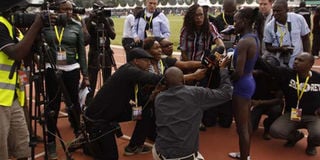Chaos impeded journalists’ work at Rio Olympics

Two-time World 10,000m champion Vivian Cheruiyot talks to journalists after winning her specialty during national trials in Eldoret on June 30, 2016. PHOTO | JARED NYATAYA |
What you need to know:
- Officials kept mum on incidents involving ejection of Kenyan officials from Games
- Kenyan media missed chances for interviews as Team Kenya sent one official to man all 10 press centres in Rio
Kenyan journalists covering Olympic Games in Rio de Janeiro had a difficult time in news gathering owing to lack of a proper communication set-up in Team Kenya, investigations into the country’s Olympic management reveal.
What made it more difficult was the fact that the International Olympic Committee (IOC) only granted Kenya a quota of five print journalists, with the rest, mainly broadcast journalists, travelling to the Games without full accreditation which limited their movement.
“Non-accredited media had accreditation from the City of Rio which had its limitation as it didn’t allow them access to training and competition venues as well as the Olympic Village,” the report by the Rio Olympic Games Probe Committee discloses.
The report adds that there was a lot of pressure from the international media seeking to interview Kenyan athletes and officials more on the issue of doping that dominated headlines at the time after an expose by German and British journalists on the eve of the Olympics claimed there was widespread use of banned substances by Kenyan athletes.
“Kenyan athletes at the Rio Olympic Games feared talking to both Kenya and international media owing to negative publicity surrounding the fight against doping in Kenya,” said the report.
The appointment of one Media Liaison Officer (MLO), Peter Angwenyi, the report explains, made it impossible to have him effectively cover all the 10 media centres at the competition venues that involved Kenya, and also at the Olympic village.
Main role of the MLO was to ensure information was readily available to Kenyan media on the ground in Rio, especially at the “mixed zone” (where athletes interact with journalists) but this did not happen on many occasions with Kenyan journalists unable to field questions to several athletes.
“On the contrary, the Jamaican delegation, had a designated MLOs at the mixed zones and ensured Jamaican media had first access to their athletes for the post-competition interviews,” said the report.
For instance, there was no communication on incidents involving the ejection of Kenyan officials, including athletics team manager Michael Rotich and sprints coach John Anzrah from the Games.
“There was also no information on the arrival of Deputy President William Ruto and other Kenyan dignitaries,” said the report.
Initially, former Standard sports editor, Omulo Okoth, had been accredited as press attaché but his status was revoked after he was accused of publishing a story in an intentional news agency to the effect that Kenya’s athletics team manager had been ejected from the Olympics.
However, the report commends Angwenyi for doing a great job in making athletes available to non-accredited Kenyan media who had no access to the Games Village and competition venues.
The report indicates that there was also no communication between the Chef de Mission Stephen Soi and the Kenyan media. It concludes that there were no official Team Kenya media briefings.
The two members from the Ministry of Sports, who travelled to Rio Olympics as an afterthought didn’t not help much since they were not accredited and had to cater for their own daily expenses since they were not on full per diem.
The report explains that Kenyan broadcast media teams had no access due to the fact that the national broadcaster, Kenya Broadcasting Corporation (KBC), enjoyed the exclusive territorial rights for free to air TV in Kenya even through it had no representative in Rio.
“SuperSport and CCTV (China) had the pay TV rights to broadcast in Kenyan territory,” said the report.





